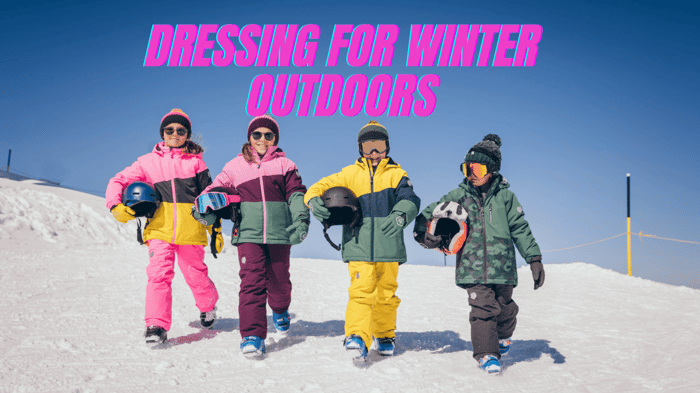Outdoor play in winter? Dressing for freezing temps takes a little know how. Here's the detailed guide that will make you a pro at winter weather dressing in no time.
Wondering how to get kids outdoors - safely and happily - when temps dip below freezing? Or maybe you live where temperatures are routinely below freezing or even below zero for most of the winter. Here's our top tips for winter weather dressing for outdoor play in freezing temperatures.
What are "freezing temps?" At face value, freezing temperatures are below 32°F (0°C). In reality, what feels like freezing is going to differ greatly - your own tolerance and what your body is adjusted to; wind chills and humidity. No matter if your idea of cold, if you're thinking you don't know how to stay warm enough outdoors, then this post is for you.

Basic layering for outdoor play means three steps plus accessories:Our tips help build on a basic understanding of layering. If you're not familiar with layering, read more here.

But what happens when it's really cold out there? Expand on the basics and get kids outdoors in winter with these tips:
- Start Comfortable: Insulation doesn't increase temperature, it maintains temperature. It's very hard to get warm while in the cold - it's much easier to stay warm. If kids are cold or wet, take time to let them warm and dry inside and then head out.
- The Fire Within: Keep your core warm. Base layers should touch skin and not hang loose, but they shouldn't be so tight as to squeeze off that blood flow - seamless base layers are a great option for kids who don't like the feel of anything "tight." The Japanese Haramaki - or belly band - is all about keeping the core temperature up and the organs warm, and by doing so, keeping the whole body warm. We carry an assortment of baselayers both wool and polyester as well as multiple blends - any of these, well fitting, is great and a critical part of keeping core warmth - and helping with step 3.
Kids Base Layer Set: Lani Marine Blue

$ 59.95
Kids' thermal underwear set made from super warm Thermolite®. With excellent temperature control, these base layers are ideal for year-round use. Room to Grow: Lani base layers run about one size larger than traditional US sizes so ordering your child’s current size… read more
Merino Wool Base Layer Ski Unders Set: Light Gray

$ 80.00
When temperatures fluctuate, these merino wool baselayer help kids stay happily at play! Wool helps maintain a comfortable core temp regardless of the weather. This long sleeve and full length pant ski underwear set is comfortable enough for lounging and even sleep.… read more
- Avoid Dampness: That critical baselayer we mentioned comes in wool and polyester or blends - all designed to wick away moisture from the skin and keep the body dry. You may have heard the phrase "cotton kills." Here's what that phrase means: Fabric keeps you warm by trapping warm air near your body. Cotton is excellent at absorbing - and when it gets wet, it stops insulating as all those air pockets fill with water. Instead of warm air against your skin, now you have a wet cloth. In some cases, cotton is just fine - there are many times outside when we don't mind at all if we're soaking wet after a bit of play: but if you're trying to say warm, you want fabric that will wick moisture off the skin, hold lots of it, and ideally help it evaporate quickly so you can keep going comfortably!

- Keep the Wind Out: There's nothing that makes a day feel miserable like that bitter wind cutting straight through your gear. It's nature's drama: and you can beat it. Seal up drafts by making sure everything overlaps and there's not gabs for wind to whip through. Balaclavas or tube scarves provide protection for your neck and ears. Jackets and mid layers should overlap their pants, or choose a one piece to make this super simple. Outer layers should be wind resistant or wind proof but also allow for breathability.
Ski pants with pockets Airflow 10K in Phantom

$ 86.00
Popular ski pants ready for any adventure. The ski pant has many practical features such as soft, adjustable and detachable suspenders, outer zipper pockets and snow skirt at the bottom to cover the boots. Features adjustable velcro straps at the… read more
Double Layer Merino Wool Balaclava: Covert Green

$ 24.00
Wool hoods stay on little heads and cover the neck to keep young explorers warm and comfortable in all weather. Oeko-tex 100 certified. Double layer balaclava by Celavi. Ribbed opening helps keep shape.– Double-layers of soft merino wool.– This product is Oeko-Tex® certified, free from harmful substances.– Crafted with Woolmark® certified… read more
- Limit Your Layers. We all know that old school image of the overdressed kid rolling down the hall so overdressed they can hardly walk - don't do that! Layer well, don't over layer. The value in each piece is key: a good wind resistant, insulated, well fitting outerlayer over a proper base layer is amazing, and you may find you don't even need an insulating layer most days!
- Stay Active: sports and physical activity are a great way to enjoy the cold days of winter. From ice skating and hockey, cross country skiing, hiking, playing tag, snowball fights and building snowmen - keep arms and legs moving! If you're moving fast: alpine skiing, snow machines or sleds, you may be creating wind that displaces hot air: you may be warmer but you'll want to prioritize wind protection.

- Don't overheat: peel layers when needed, getting rid of the middle layers first if possible. If you're active in a sport or area where you don't have wind to worry about, you can keep the middle layer and ditch the outer - but I always encourage kids to keep their hats on to prevent rapid loss of body heat - if you need, switch to a thinner hat or use a thin tube scarf as a head cover.
- Make accessories count: The right hat fits well, stays in place, and addresses your needs. Some hats sit off the head a bit to allow a pocket of warm air; our tube scarves worn as a hat or running headbands wick moisture and keep cold air off the skin. Wool socks keep feet warm and dry. Mittens are warmer than gloves, but either way, allow a bit of room for warmth and make sure there's no gap between sleep and glove. Dry heads, hands, and toes are game changers: for a long day outside, bring extras and change out. If you're close to a car or building, it's easy to keep an extra bag on hand and you'll have it if you need it.
Waterproof Snow Mitten: Orange Clown Fish

$ 32.00
Waterproof winter play mittens, waterproof and adjustable at the wrist, made from recycled material. Reflectors for extra safety. Waterproof mittens by Color Kids With clips to link them together With strap and velcro closure Waterproof Made from recycled material Composition:… read more
- Waterproof & Warm Footwear: Wool socks if at all possible. If you cannot do wool or animal products, fleece or poly is an option. On littles, wool stockings are a great option because they help avoid gaps open created when in a deep squat position as is created when babywearing. You can add a wool sock over or just a pair of waterproof, windproof insulated booties. For older kids, a wool sock overlapping baselayer pants (no gaps!) and a thick soled, insulated and waterproof winter boot.
Why thick soles? Just like radiating heat loss from an uncovered head; we lose a lot of body heat and chill fast by conduction: contact with a cold surface. Thick soles are an easy and accessible way to insulated feet. But there are of course draw backs: thick soles are heavy and less flexible; and you lose that connection and feedback from the terrain. Our neoprene winter boots have a minimal drop and wider toe box to keep the feet as happy as possible! Minimalist shoes with thinner soles can be incredibly beneficial, but less accessible and less affordable. Winter versions will typically have a thick wool lining - a great addition to any winter shoe. Learn how to DIY your own here!
- Don't be afraid to try. A short time outside might end in cold bodies but if you come in and warm up before anyone is uncomfortable, you'll be willing to try again. And practice, well, it makes for a perfect winter at play.

See you out there!






